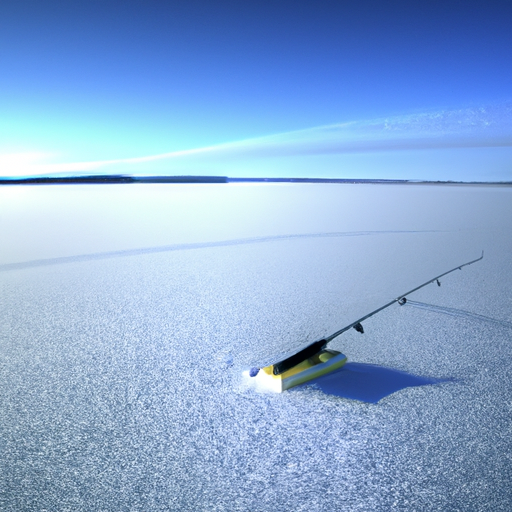Imagine heading out onto the frozen tundra, armed with just your fishing gear and a desire for adventure. But wait, you forgot your tip-ups! Can you still go ice fishing without them? This article explores the essential tips and techniques for ice fishing without tip-ups, ensuring you have a successful and thrilling experience on the ice. From using jigging spoons to finding the perfect location, discover how to make the most of your ice fishing trip without relying on traditional tip-ups.

Safety Precautions
Ice fishing can be a fun and thrilling winter activity, but it’s important to prioritize safety. Before heading out onto the ice, it’s crucial to check the ice thickness. Ice needs to be at least four inches thick to safely support a single person, and even thicker for groups or vehicles. You can use an ice auger or spud bar to check the ice thickness along your fishing route.
In addition to checking ice thickness, wearing appropriate clothing is essential for staying safe and comfortable while ice fishing. It’s advisable to dress in layers to trap heat and insulate your body. Opt for moisture-wicking fabrics as your base layer, followed by insulating layers like fleece or wool, and finish with a waterproof outer layer to protect against snow and moisture. Don’t forget gloves, hats, scarves, and warm socks to keep your extremities cozy.
Bringing safety equipment is another crucial aspect of ice fishing. You should always have a life jacket or personal flotation device (PFD) with you, even if you’re confident in your swimming abilities. Ice picks or ice awls are also essential tools that can help you pull yourself out of the water in case of an emergency. It’s better to be prepared and have these items on hand than to find yourself in a dangerous situation without them.
Rod and Reel Basics
Choosing the right rod length and weight is instrumental in finding success while ice fishing. Shorter rods in the range of 24 to 36 inches are recommended for ice fishing because they provide better control and allow you to maneuver in small spaces. Light or ultralight rods are ideal for ice fishing as they allow you to detect even the slightest nibble and provide an enjoyable fishing experience.
When it comes to selecting an appropriate reel for ice fishing, spinning reels are a popular choice. They offer smooth casting and retrieval, making them suitable for a wide range of fish species. It’s important to choose a reel with a sturdy construction and a smooth drag system, as these factors can greatly impact your overall fishing experience.
Spooling up with suitable line is another crucial aspect of rod and reel basics. Monofilament line is commonly used for ice fishing due to its versatility and affordable price tag. It has good knot strength, low memory, and is less likely to freeze compared to other types of fishing lines. However, some anglers prefer using fluorocarbon lines for their increased invisibility in the water and higher abrasion resistance.

Bait Selection
Understanding the fish species you’re targeting is essential for selecting the right bait. Different fish have different feeding habits, so it’s important to do some research or consult local anglers to determine the most effective bait options. Live bait, such as minnows, worms, or waxworms, is a popular choice for ice fishing as it can attract a wide range of fish species.
Artificial bait can also be effective, especially when targeting specific fish species. Jigs, spoons, and soft plastic baits can mimic the movements and appearance of various prey and can be used to entice fish to bite. It’s important to experiment with different colors, sizes, and shapes to determine what works best for the fish species you’re targeting.
Consider using scent attractants to enhance your bait’s effectiveness. Many ice anglers swear by scents like anise, shrimp, or garlic, which can mask human smells and attract fish to your presentation. This can be particularly helpful when ice fishing in murky or stained water where visibility is limited.
Location and Depth
Identifying suitable fishing spots is a crucial part of a successful ice fishing trip. Research local fishing reports or consult experienced ice anglers to get insights into popular fishing areas and hotspots. Look for areas with underwater structures, such as drop-offs, weed beds, or submerged vegetation, as these can attract fish.
Determining the ideal depth to fish at can greatly increase your chances of catching fish. Different species of fish prefer different depths, so it’s important to have an understanding of their behavior. For example, panfish like crappie and bluegill are often found in shallower waters, while larger predator fish like northern pike or walleye may seek deeper waters.
Using sonar or depth finders can greatly enhance your ice fishing experience. These devices provide real-time updates on water depth, underwater structures, and the presence of fish. By utilizing this technology, you can fine-tune your fishing strategy and increase your chances of success.

Setting Up Your Fishing Area
Before you start fishing, it’s important to clear the ice from snow and slush. This ensures a clean and safe fishing area, as well as improves your visibility into the water. Use a snow shovel or a broom to remove any snow or slush from the ice surface.
Creating a comfortable fishing hole is essential for an enjoyable ice fishing experience. Ice augers or ice saws are commonly used to drill holes in the ice. The size of the hole depends on your fishing technique and personal preference. Six to eight inches in diameter is generally sufficient for most ice fishing scenarios.
Ice Fishing Techniques
Jigging is a popular ice fishing technique that involves using a jig or baited hook to create subtle or aggressive movements in the water. Lift and drop the rod tip in a rhythmic motion, imitating the movement of injured baitfish. This action can attract the attention of fish and entice them to strike. Varying the jigging speed, depth, and pause intervals can help you determine the fish’s behavior and preferences.
The deadstick method is another effective technique for ice fishing. It involves using a longer rod with a sensitive tip and setting it in a rod holder or balanced on a bucket. The bait is left to sit still in the water, enticing fish with its scent and natural movement. This technique can be particularly effective when targeting finicky or bottom-dwelling fish.
Using bobbers or floats is a popular technique for ice fishing beginners. Simply attach the baited hook to the line, set the bobber at the desired depth, and wait for it to disappear under the water. This method allows for a more passive fishing approach and can be effective for various fish species. Adjust the bobber’s depth based on the fish’s feeding habits and preferences.

Staying Warm
Dressing in layers is key to staying warm during your ice fishing adventure. Layering allows you to easily adjust your clothing to match the changing weather conditions and your activity level. Start with a moisture-wicking base layer to keep sweat away from your skin. Add insulating layers like fleece or wool to trap heat, and finish off with a windproof and waterproof outer layer.
Using portable heaters or ice shelters can provide a cozy and comfortable fishing environment, especially during extremely cold weather. Portable heaters can be powered by propane and are designed to provide warmth in small spaces. Ice shelters, also known as ice fishing tents or shanties, provide protection from the wind and cold, creating a more enjoyable fishing experience.
Taking breaks to warm up is important for maintaining your body temperature while ice fishing. Step into a heated shelter, warming hut, or nearby vehicle every so often to let your body thaw out. Drink warm fluids and have a snack to replenish your energy levels. By taking care of yourself and staying warm, you’ll be able to enjoy your ice fishing adventure to the fullest.
Maintaining Focus and Patience
Ice fishing requires a certain level of focus and patience. Practicing mindfulness can help you stay present and fully immerse yourself in the experience. Pay attention to the sights, sounds, and sensations around you, and let go of any distractions or thoughts that may hinder your enjoyment.
Avoiding distractions is key to maintaining focus while ice fishing. Put away your phone or other electronic devices that may divert your attention from the task at hand. Be fully present in the moment and embrace the peacefulness and tranquility of ice fishing.
Staying patient throughout the process is crucial. Fish behavior can be unpredictable, and you may need to wait for extended periods before getting a bite. Use this time to relax, enjoy the surroundings, and appreciate the beauty of nature. Remember, the waiting game is part of the fun and excitement of ice fishing.

Hooking and Landing Fish
Mastering the art of setting the hook is essential for successfully landing fish while ice fishing. When you feel a bite, quickly and sharply raise your rod tip to set the hook in the fish’s mouth. A firm hookset is crucial to prevent the fish from escaping. Practice your hooksetting technique to improve your success rate.
Reeling in the fish confidently is the next step after hooking it. Use a smooth and steady reeling motion, keeping the tension on the line. Avoid jerking or yanking the rod, as this can cause the line to break or the fish to escape. Keep the fish’s head up and guide it towards the fishing hole.
Using appropriate landing techniques ensures the fish’s safety and minimizes harm. If you plan to keep the fish, use a net or lip grip to safely retrieve it from the water. Properly handle the fish with wet hands to protect its slimy coating and avoid damaging its delicate scales. If you’re practicing catch-and-release, handle the fish minimally and return it to the water as quickly as possible.
Etiquette and Conservation
Respecting fishing regulations is essential for maintaining healthy fish populations and preserving the natural environment. Familiarize yourself with local fishing regulations, including size limits, bag limits, and seasonal restrictions. Follow these guidelines to ensure the sustainability of fish populations and to protect sensitive areas.
Practicing catch-and-release is a responsible approach to fishing. By releasing some or all of your catch, you contribute to the conservation and replenishment of fish populations. Handle fish carefully to minimize stress and injury, and ensure they have time to fully recover before returning them to the water.
Cleaning up after yourself is crucial not only for the environment but also for the enjoyment of future anglers. Dispose of any trash, including fishing line, bait containers, and food wrappers, in designated waste receptacles. Leave the fishing area in the same condition (or better) than you found it, ensuring a clean and welcoming environment for everyone to enjoy.
By following these essential tips and techniques, you can enjoy a safe, successful, and enjoyable ice fishing experience. Whether you’re a beginner or an experienced angler, ice fishing offers a unique opportunity to connect with nature, challenge yourself, and create lasting memories. So bundle up, gather your gear, and head out onto the ice for a winter adventure like no other!





